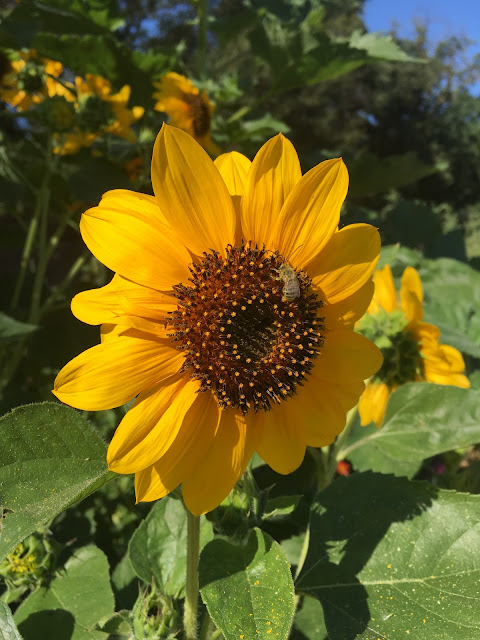
Sacramento Perennial Plant Club hosts honey expert and plant sale

|
|
Bees and sunflowers are a natural match. Learn about bees
from Frank Lienert and buy sunflowers (and other plants) at
the meeting of the Sacramento Perennial Plant Club. (Photo:
Kathy Morrison)
|
Feel the buzz! Learn about beekeeping – and the importance of pollinators – from one of the Sacramento Valley’s best-known beekeeping families.
Set for 7 p.m. Thursday, June 23, at Shepard Center, the Sacramento Perennial Plant Club hosts Frank Lienert of Lienert’s Honey. He’ll discuss the life cycle of honeybees and beekeeping. The public is welcome; admission and parking are free.
Lienert’s father started beekeeping more than 60 years ago in Davis. One hive – purchased from Sears & Roebuck to pollinate a boysenberry patch – turned into a full-time family business. With about 10 different varietals (clover, orange blossom, sage, etc.), Lienert’s Honey can be found at local grocery stores and farmers’ markets. (For more information, see www.lienertshoney.com .)
Help the bees in your own landscape – and add some summer color, too! At this same meeting, the Perennial Plant Club will hold a summer plant sale.
Say the organizers, “Locally grown and selected to add color and floral zing to our summer gardens as well as food for our pollinators, (the sale includes) Ageratum, Black-Eyed Susan, Calendula, Cosmos, Gomphrena, Strawflower, Sunflower, Tithonia, Zinnia, Feverfew, Foxglove and Hollyhock plants. They also make great cut flowers. ” (Good timing, too: This week is National Pollinator Week.)
Annuals are priced $2 each or three for $5. Perennials are $3 each or two for $5. Bring your own box or bag to take home your purchases. Cash only.
Come early and bring your pruners that need sharpening or containers that need holes; at 6:30 p.m., tool sharpening and pottery drilling will be available for a donation.
Shepard Garden and Arts Center is located at 3330 McKinley Blvd., Sacramento, in McKinley Park.
Details: https://www.facebook.com/sacperennialplantclub/ .
Comments
0 comments have been posted.Sacramento Digs Gardening to your inbox.
Food in My Back Yard Series
April 1: Don't be fooled by these garden myths
March 25: Fertilizer tips: How to 'feed' your vegetables for healthy growth
March 18: Time to give vegetable seedlings some more space
March 11: Ways to win the fight against weeds
March 4: Potatoes from the garden
Feb. 25: Plant a fruit tree now -- for later
Feb. 18: How to squeeze more food into less space
Feb. 11: When to plant? Consider staggering your transplants
Feb. 4: Starting in seed starting
Sites We Like
Garden Checklist for week of March 30
Your garden doesn’t mind April showers. Get busy now to enjoy those future flowers.
* Get ready to swing into action in the vegetable garden. As nights warm up over 50 degrees, start setting out tomato, pepper and eggplant transplants.
* From seed, plant beans, beets, cantaloupes, carrots, corn, cucumbers, melons, pumpkins, radishes and squash. (Soak beet seeds overnight in water for better germination,)
* Plant onion sets.
* In the flower garden, plant seeds for asters, cosmos, celosia, marigolds, salvia, sunflowers and zinnias.
* Transplant petunias, zinnias, geraniums and other summer bloomers.
* Plant perennials and dahlia tubers for summer bloom.
* Transplant lettuce and cabbage seedlings.
* April is the last chance to plant citrus trees such as dwarf orange, lemon and kumquat. These trees also look good in landscaping and provide fresh fruit in winter.
* Smell orange blossoms? Feed citrus trees with a low dose of balanced fertilizer (such as 10-10-10) during bloom to help set fruit. Keep an eye out for ants.
* Apply slow-release fertilizer to the lawn.